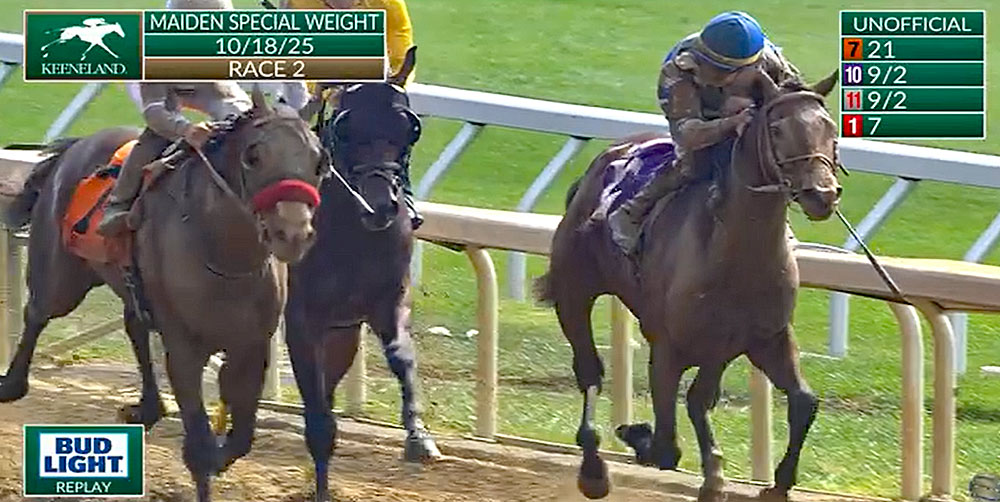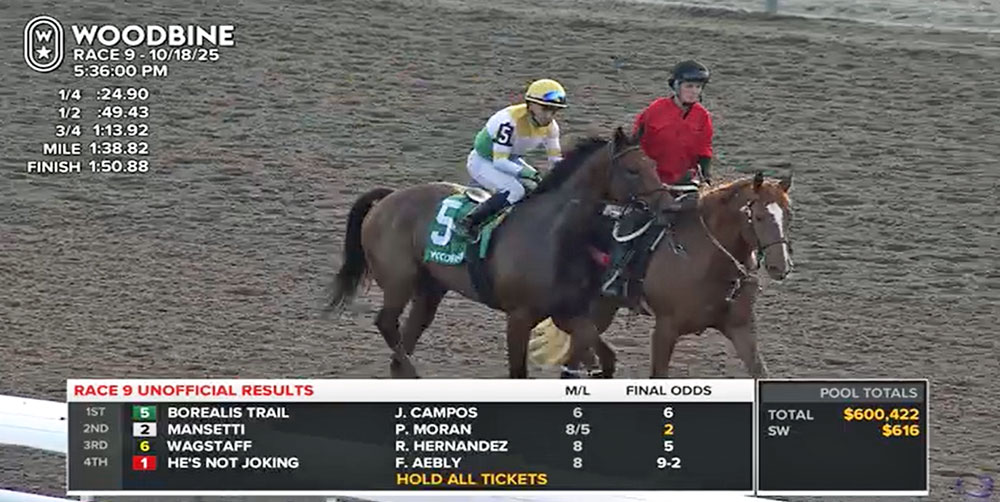October Player’s Choice Handicapping Tournament winner Trevor Tilston-Jones.
By G.S. Thompson
Trevor Tilston-Jones won the first Player’s Choice Handicapping Tournament of the off-season at ASD last Saturday, and it wasn’t close.
The 2022 Handicapper of the Year built his bankroll to $128.40 to win the contest for the third time, and he started with a bang, catching a 20-1 winner on his first bet. Trevor defeated Brad Ostrove by $21.70 to take home the $1,000 first prize, bragging rights, and the trophy.
Runner-up Ostrove finished with a respectable total of $106.70, but it must have been a tough day for longshots, as it was a long way back to third-place finisher Darcy Penner ($86.90), followed by Larry Liebrecht ($79.10) and Roger Jones ($78.00).
Just 32 minutes into the contest, Trevor caught cap-horse lightning with 20-1 Vitruvian Man in Keeneland’s second race. Vitruvian Man paid $42.50, $16.10, $10.50 across the board, providing a bankroll cushion that would prove insurmountable.
The play was pure Trevor. Vitruvian Man had two career starts, both on grass at Kentucky Downs, and here he was switching to dirt at Keeneland. “They put blinkers on him,” he said. “And when you see blinkers on a horse along with immeasurably better workouts, that’s something.”
The pedigree didn’t hurt either. The horse was by Breeders’ Cup Classic winner Vino Rosso, and trained by Doug O’Neill, with jockey Joel Rosario in the irons. “Everything was positive as far as I was concerned,” said Trevor, who also took Vitruvian Man’s last race into account — a fifth-place finish at Kentucky Downs from post 12. The winner had cleared by eight and a half lengths, and his horse had lost by 11. Simple subtraction told him the horse had only lost three lengths to the second-place finisher. That was the kind of angle most players miss when they see “beaten 11 lengths” and move on.
Vitruvian Man, who was about 10 lengths back on the turn for home, came with a long, sustained rally to get up by a sliver over another rival who rallied up the rail. The finish was so close you couldn’t tell who won, but the photo finally said Vitruvian Man.

Vitruvian Man (#7 outside) gets up just in time at 21-1 in the second race at Keeneland last Saturday.
Trevor added another winner in the 9th race at Woodbine, when Borealis Trail won the Ontario Derby and paid $14.90, $6.00, $4.40 across the board. The horse had finished second beaten a head in the Breeders’ Stakes, with the rest of the field more than five lengths back, and he was just the right price on contest day at 6-1.
That’s the Trevor Tilston-Jones approach in a nutshell. Look for horses that have shown something against top competition. Watch for equipment changes that signal intent. And don’t be afraid to go against the grain when the angles align.
Trevor’s handicapping toolkit is deeper than most. He looks for seasonal patterns, blocking off dates when horses were successful the previous year and watching for those same hot streaks to repeat. He knows that in late October, some horses might be tired after long campaigns while others have been saved for cooler weather. “Sometimes they’re prepping them for the time of year when the horse wins or does better,” said Trevor.

Borealis Trail ensured contest victory for Trevor Tilston-Jones when he won the 9th race at Woodbine last Saturday.
Trevor is a believer in Beyer Speed Figures as a starting point, using them to eliminate horses that have never run fast enough to compete at today’s level, but he sees figures as a tool, not a religion.
For the contest itself, Trevor had a strategy: don’t overthink it.
“You can’t look at a race for 25 to 30 minutes,” said Trevor. “You have 10 picks to make, you better do them, and you better get going because you could be wrong in the race that you’re looking at for that long.”
It’s about trusting your preparation and your instincts, not getting paralyzed by analysis. Make your plays and move on.
Trevor’s background as a manufacturer’s agent shaped his handicapping philosophy more than most would guess. “I had all these different customers with different minds and different angles,” he said. “I had my own philosophies, and I had to use different ones with them. So I guess that’s what my handicapping style was born from, figuring out that you can’t just hone in one thing.”
He’ll use whatever tool the race requires, whether that’s trainer statistics, equipment changes, breeding angles, or pure form analysis.
Trevor’s history with Assiniboia Downs runs deep. He came to the track with his father and saw the very first race ever run at ASD, a connection to the track that spans decades and gives him a perspective few handicappers possess.
Now 79, he sees handicapping as more than just a hobby. It’s a mental exercise, a way to stay sharp when peers are fading into retirement without outlets.
“When you get older and you’re at my age, it’s something you can do that’s enjoyable,” said Trevor. “And it keeps your mind alert. Because if you’re just sitting around when you retire and go home, you’re going to die. You have no hobbies, no fantasy football, no memorabilia, none of this.”
Trevor still works part-time and makes calls to keep his mind engaged, but says handicapping provides the same kind of intellectual stimulation others might find in crosswords or Sudoku. But sometimes…
This puzzle pays out.

